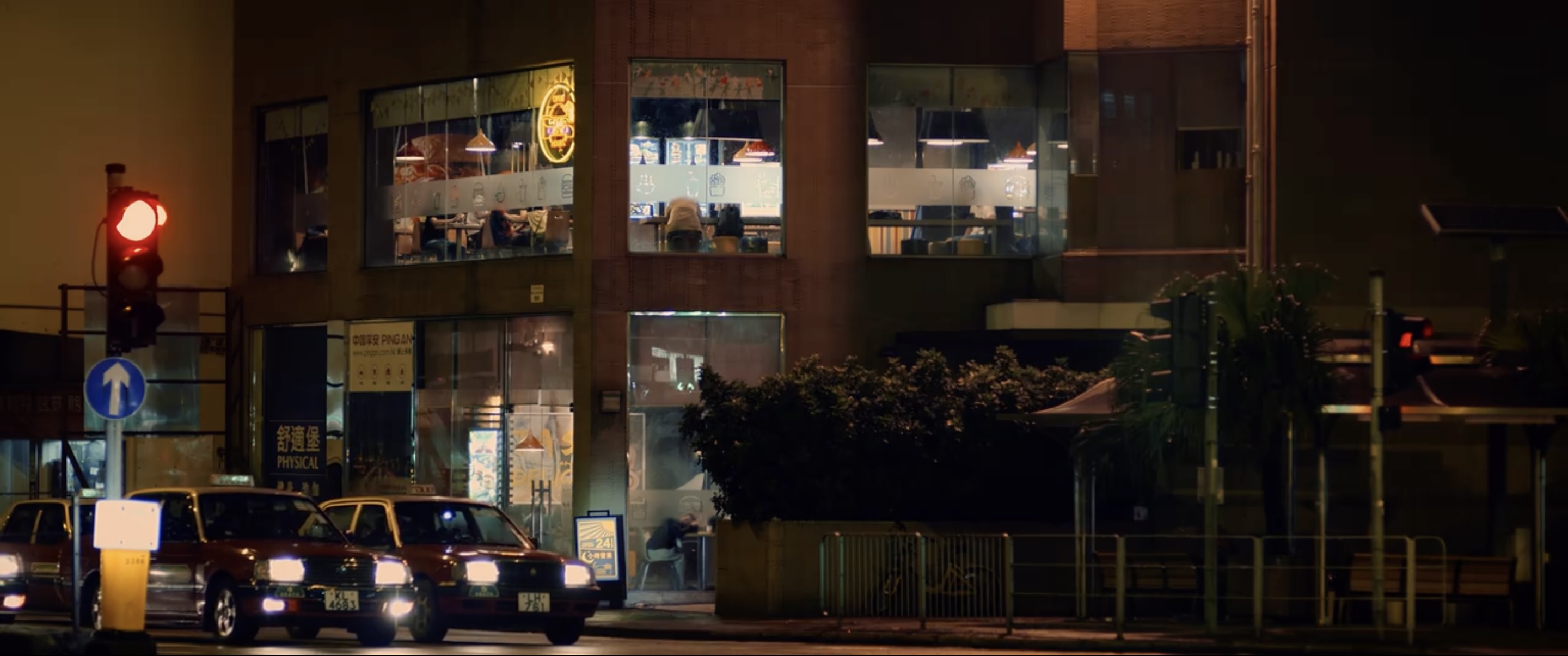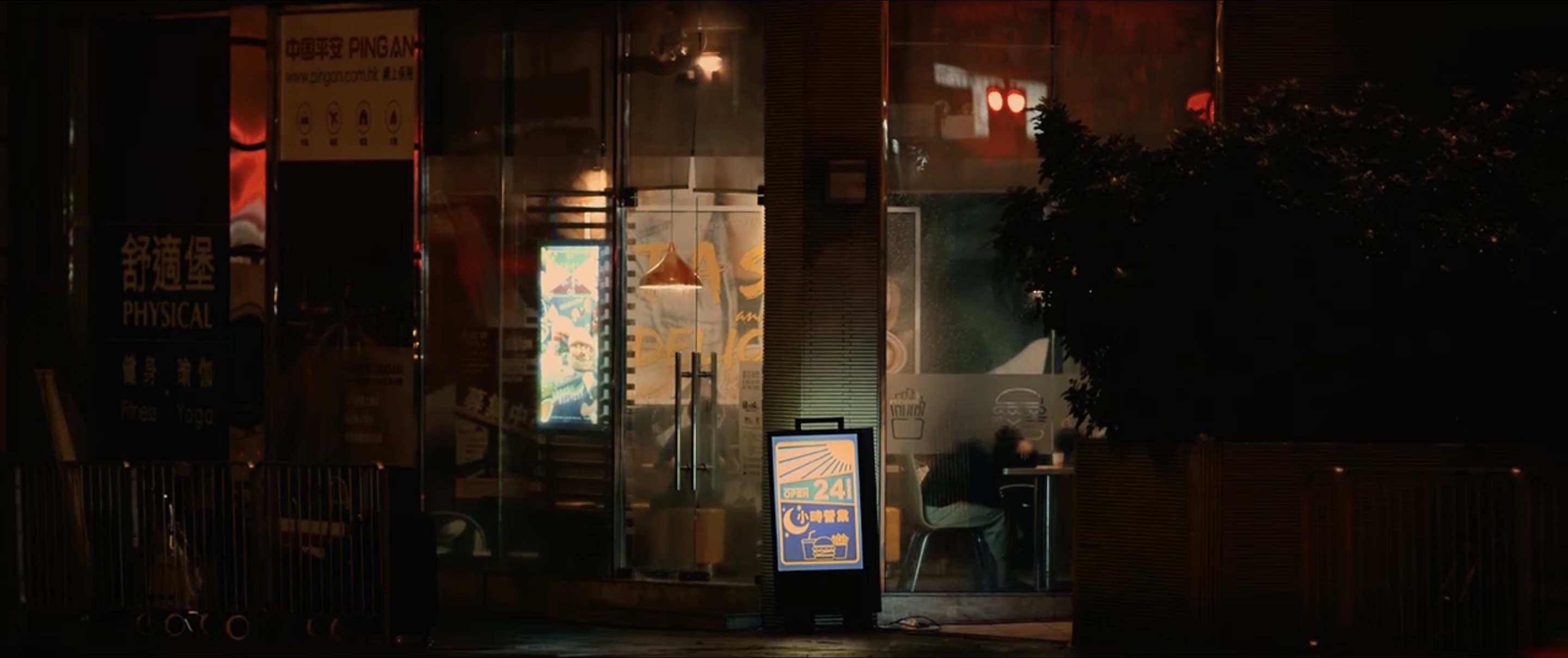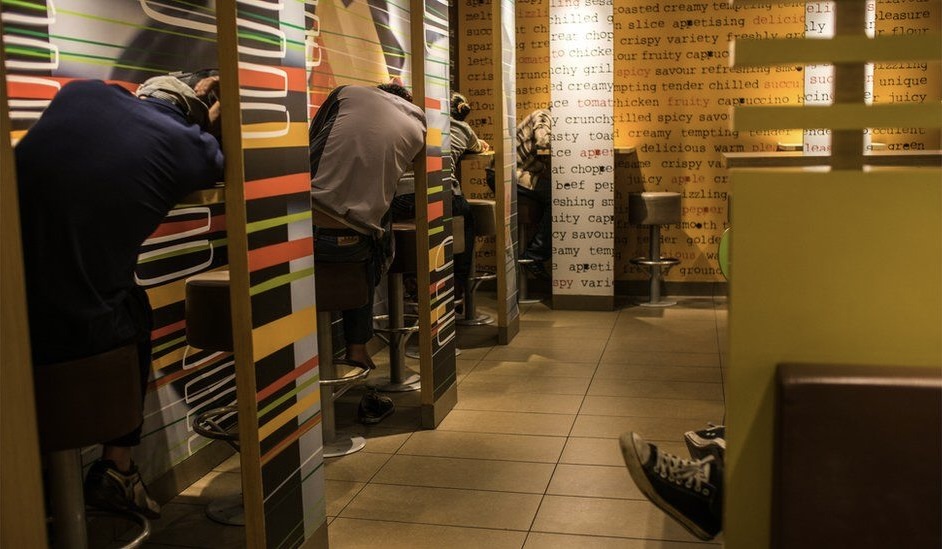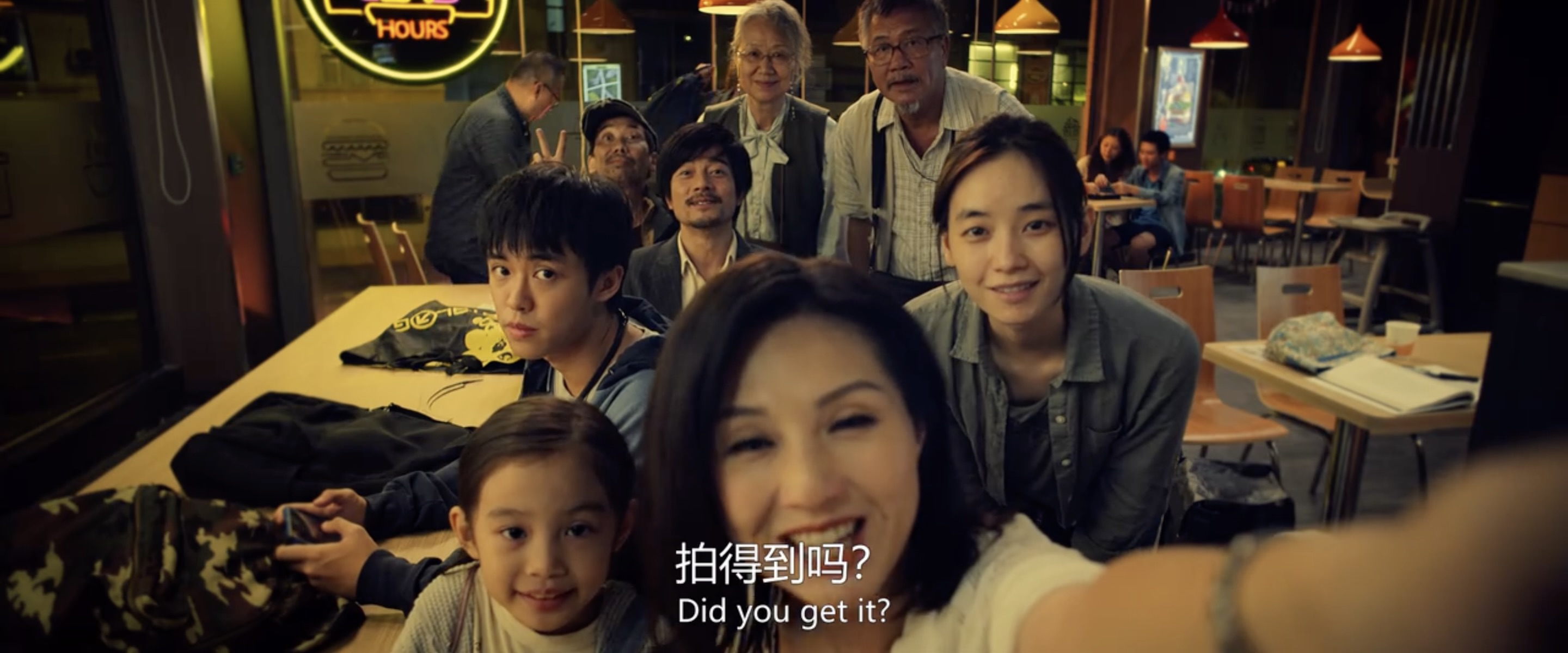I’m Livin’ It, DIR. Danny Wong (2019)
McDonald’s, Yaumatei (supposed, as it is artificially constructed with reference to several real McDonald shops), Hong Kong

 Figure 1. McDonald’s is the only working shop with bright light and neon board in the streets. Scenes from I’m Livin’ it 2019, directed by Danny Wong.
Figure 1. McDonald’s is the only working shop with bright light and neon board in the streets. Scenes from I’m Livin’ it 2019, directed by Danny Wong.
I’m Livin’ It (2019), named after McDonald’s advertising slogan “I’m Lovin’ It,” is a Hong Kong drama film directed by Danny Wong. Focused on a special group of lower-class vagrants, “McRefugees,” namely Bowen, Sam, and Uncle Wait alike, who stay overnight in the McDonald’s, this film narrates how these people carry on their tough lives, in which “McDonald” not only functions as a physical place of their temporal shelter but also as an epitome suggesting how the low-class people struggle to make a living in the modernized Hong Kong urban life.
The film opens with a crowded public housing estate where a boy has a quarrel with his family,[1] and leaves to the street, whereupon a two-storied McDonald shop appears (Figure 1), followed by its interior scene. McDonald’s is located and integrated into the residential areas except for its brilliant neon logo broad. Huge French windows through which viewers might notice the capacious interior space and “McRefugees” sleeping at the tables, and the restaurant’s bright lighting contrasts with the gloomy midnight outside, both suggesting its 24-hour temporality. Warm light, large room, colourful decoration, and a convenient location altogether produce the McDonald’s another quality beyond a fast-food restaurant, as indicated in the film: a comfortable shelter where vagrants will gain both rest and decency.
 Figure 2. The interior of McDonald’s in the film is a bit dim despite the bright-coloured furniture. Scene from I’m Livin’ it 2019, directed by Danny Wong.
Figure 2. The interior of McDonald’s in the film is a bit dim despite the bright-coloured furniture. Scene from I’m Livin’ it 2019, directed by Danny Wong.
 Figure 3. A photograph of real McRefugees taken by an Indian photographer Suraj Katra. BBC News, “The night time ‘McRefugees’ of Hong Kong,” 2015.
Figure 3. A photograph of real McRefugees taken by an Indian photographer Suraj Katra. BBC News, “The night time ‘McRefugees’ of Hong Kong,” 2015.
It should be noted that despite some parts of artistic modification, I’m Livin’ It is a realistic film that captures and presents an unfamiliar side of McDonald which appears to be dramatic and filmic against the most citizens’ familiar reality, experienced as a normal modern restaurant filled with busy consumers. However, the phenomenon of McRefugees turns out to be the very reality, exactly as represented in the film. Mostly shot in the nighttime, the film presents the McDonald’s interior dimmed in a quiet and restrained atmosphere, completely different from its busy and noisy daytime. Even McDonald’s classical red and yellow ceiling lamps and light-coloured tables seem darker and heavier. Similarly, the whole interior is more shadowy than the reality (see Figure 2 & 3), which I consider as an externalization of the characters’ psychologies. Above all, the McDonald’s shelter function is temporal as the McRefugees have to leave in the morning (Figure 4). There is a sequence in which Bowen awakens Sam, and behind them, a young couple is enjoying their breakfast, which highlights the division and contrast between the normal consumers and Bowen alike. The temporality of McDonald’s space exemplifies de Certeau’s theories of how strategies and tactics dominate space. Usually, McDonald’s serves as a consuming and dining place, one viewers are familiar with in reality. However, as for those staying overnight there, McDonald is a “place of tactic” which “belongs to the other,” and a place that they “insinuate [themselves] into … fragmentarily, without taking it over in its entirety, without being able to keep it at a distance.”[2] In the place of tactic, McRefugees achieve “a victory of time over space” as they “watch for opportunities that must be seized ‘on the wing’.”[3]
 Figure 4. Bowen awakens Sam in the morning, behind them is a couple enjoying the breakfast that strongly contrasts with their abject situation. Scene from I’m Livin’ it 2019, directed by Danny Wong.
Figure 4. Bowen awakens Sam in the morning, behind them is a couple enjoying the breakfast that strongly contrasts with their abject situation. Scene from I’m Livin’ it 2019, directed by Danny Wong.
McDonald’s as a “place of tactic” is the motif of the film that distinguishes the work from others merely documenting and reporting McRefugees. Apart from the artificially constructed “McDonald’s shop,” the film includes more shots of the conventional and historical local architectures in Hong Kong, ranging from Tin Hau Temple and Kwun Yum Temple in Yaumatei, a small music bar on Temple Street, Yaumatei Kaifong Association School, and several alleyways and corners among which the characters rush about to make a living.[4] These sites form a geographical triangle where the characters themselves are connected as a community, a “spatial trajectory” producing narrative even outside the place of McDonald where their activities overlap and intersect.[5] “Space is composed of intersections of mobile elements … [being] actuated by the ensemble of movements deployed within it.”[6] In that sense, McDonald in this film never denotes a place of “stability,”[7] but a space where McRefugees apply “tactics” to temporally dominate as a transition. Simultaneously, we viewers should notice that just like other consumers, McDonald’s is a happy, gathering place for the “refugees” to support each other despite their struggling to survive (Figure 5). The tone of McDonald’s during their nighttime, a bit shady though, is warm, gleaming and colourful, just as a lighthouse in the desperate dark, directing and inspiring the McRefugees to leave the place one day.[8]
 Figure 5.1. Characters gather in McDonald’s to collect money for Bowen who is confirmed with cancer. Scene from I’m Livin’ it 2019, directed by Danny Wong.
Figure 5.1. Characters gather in McDonald’s to collect money for Bowen who is confirmed with cancer. Scene from I’m Livin’ it 2019, directed by Danny Wong.
 Figure 5.2. Characters take a “family group photo” in McDonald’s. Scene from I’m Livin’ it 2019, directed by Danny Wong.
Figure 5.2. Characters take a “family group photo” in McDonald’s. Scene from I’m Livin’ it 2019, directed by Danny Wong.
Notes:
[1] The estate consists of a square courtyard surrounded by four buildings on its four sides, which is similar to the Ping Shek Estate in Kowloon, Hong Kong.
[2] Michel de Certeau, “General Introduction,” in The Practice of Everyday Life, trans. Steven Randall (University of California Press, 1984), xix.
[3] Ibid.
[4] Hing-fan Danny Wong, “Space, Time, and Finding Home,” by Eunice Seng, Faculty of Architecture, University of Hong Kong, open lecture. March 23, 2021. https://www.arch.hku.hk/event_/wong-hing-fan-%e9%bb%83%e6%85%b6%e5%8b%b3/?subcat=auhi.
[5] Michel de Certeau, “Spatial Stories,” in The Practice of Everyday Life, trans. Steven Randall (University of California Press, 1984), 115.
[6] Ibid., 117
[7] As argued by de Certeau, “A place […] implies an indication of stability.” ibid.
[8] As emphasized by Danny Wong in the same interview, McDonald is never a destination and resolution as the McRefugees should leave McDonald, getting rid of their plight finally (except for some particular cases, such as Uncle Wait, a rich elderly who stays there overnight to overcome the psychic trauma caused by his wife’s suicide). Hing-fan Danny Wong, “Space, Time, and Finding Home.”
— Vana Wei Yihan (3035637448)
I appreciate your deep fieldwork and multidimensional citation. It is an incredibly reflective fieldwork report that views social-wide phenomenon in a microcosm, especially comparing McDonald’s with a “place of tactic”. However, I would suggest separating some attention to lens language and how the filmmaker artistically modified the environmental set.
Thank you so much for your comments and suggestions!
In terms of lens language and the filmmakers’ artistic modification of the environment, I have explored a bit in the second and third paragraphs, in which I mainly discussed that 1) the camera captures a gloomy interior space while still with warm lights, suggesting the possible hope and warmth among characters; 2) comparing the film lens and the real McDonald’s at night, filmmaker deliberately darkens the lighting to fit the film atmosphere and emphasize the characters’ depressed psychologies.
However, I notice a point I did not discuss in the film concerning the composition within the lens: the characters are usually staged within the architectural structures, as shown in Fig 2, 4, and 5.1. I think such framing of lens language, with either the ceiling lamps or railings occupying the foreground, delivers a sense of spatial compression or constriction, embodying the characters’ being limited and confined into a small, dark space within a metropolis.